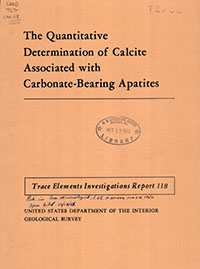The CO2 combined as calcite in carbonate-bearing apatites as been distinguished from that combined as carbonate-apatite, or present in some form other than calcite, by use of X-ray powder patterns, differential thermal analyses, and differential solubility tests. These methods were applied to several pure apatite minerals, to one fossil bone, and to a group of phosphorites from the Phosphoria formation of Permian age from Trail Canyon and the Conda mine, Idaho, and the Laketown district, Utah. With the exceptions of pure fluorapatite, pure carbonate-flueorapatite, and one phosphorite from Trail Canyon, these substances contain varying amounts of calcite, but in all the samples an appreciable part of the carbonite content is not present as calcite. The results of solubility tests, in which the particle size of sample and the length of solution time were varied, imply that the carbonate content is not due to shielded calcite entrapped along an internal network of surfaces.


